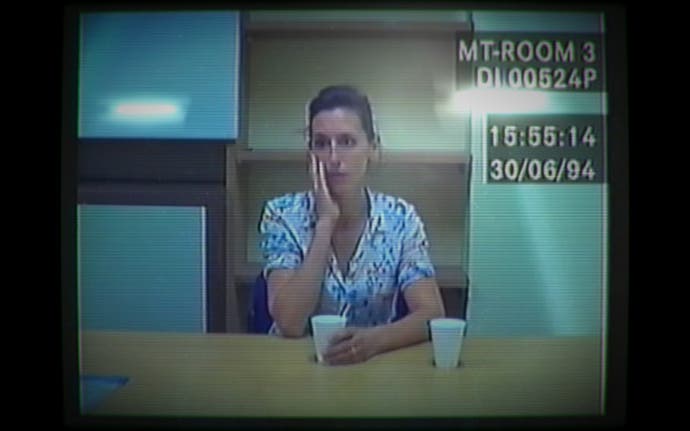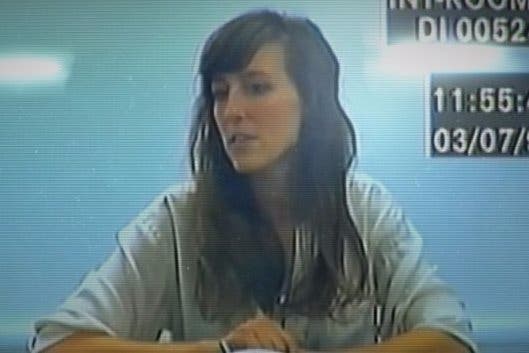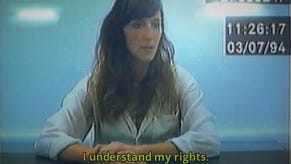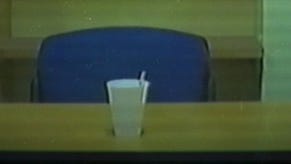His Story: How Sam Barlow rewrote the video game script
Police procedural generation.
One day in early 2014 Sam Barlow placed a scrap of paper on the kitchen table at his home on the South Coast of England. A few weeks earlier he had left a lucrative job as game director at Climax Studios. The games that he had made during his decade spent at the studio had won awards and yet, no amount of accolades had managed to shrug the nagging frustration that Barlow felt about storytelling in the medium. Where were the stories about domestic-scale drama? Where were the stories about characters who aren't 'aspirational' in some fantastical way, or stories about supposedly less marketable genders and races? Where, for that matter, was that most valuable tool in any fiction writer's pocket: subtext?
Barlow took a pen and began to write a simple manifesto, one that outlined all of the assumptions about video game storytelling of which he wanted to be free, and the characteristics with which he wanted to replace them.
'I will go deep on story, explore authentic and true characters,' he wrote. Then, with a storyteller's flourish: 'For my first trick I will make:
A game with no meaningful state change
A game without 'presence'
A game about subtext.'
Barlow has always enjoyed an askance view on the world. When he was a boy, for a while nobody realised that he needed spectacles. Such are the perils of a peripatetic childhood. Life began in Yorkshire, but his family moved frequently, including a two-year stint in Tanzania when Barlow was five years old. In the displacement, neither parent nor teacher had time to notice Barlow's poor eyesight. "I was never considered particularly bright or academic," he says. That changed when, eventually, Barlow was given a pair of glasses.

As the world flicked into focus, Barlow became an ardent reader. The local library provided a portal into alternate worlds, which Barlow found alluring after his time spent in Tanzania when, he says, he saw that food, landscapes, language and religion were not constants in the world. Such was his reading habit that Barlow maxed out not only his own library card but also those of his brothers. "I had thing for short French novels," he says. One day he borrowed a copy of Delacorta's Luna, a slim thriller about a teenage girl who is kidnapped by a man who wants to turn her into a dragonfly to enact his fantasies. "For the longest time I thought I'd dreamed it, because what the hell was that doing in a school library?"
Input soon translated to output. Barlow began to write "terrible Hobbit rip-offs" which, in time, evolved into intricate text adventures that he forced his friends play. "Usually they would involve having to endure embarrassing scenarios," he recalls. Barlow and his friends were fans of the British sitcom Bottom, with its scatological brand of irreverent humour. Bottom's influence infused those early stories. "We'd force each other to fail and fail and fail again in love. I got a taste for an adversarial author and player relationship. But I never connected the dots to wanting to tell stories professionally. I guess 'storyteller' wasn't on the list of careers that they handed out at my school."
Storyteller was, however, Barlow's vocation. Earlier this month, the designer's first independently produced game, Her Story, won three BAFTA awards, for 'Debut Game', 'Mobile and Handheld Game' and 'Game Innovation'. These trophies complement a clutch of existing awards, including the desirable IGF's Seumas McNally Grand Prize for 'Best Independent Game', which Barlow collected in San Francisco in March.
The police procedural, in which players investigate the 1994 murder of a British man, is told through three hundred video clips culled from police interview tapes, which, confusingly, cannot be watched in chronological order. Instead, you use search terms to query a database. Clips that feature the queried word are then presented for viewing. What could have been a bewildering format instead beguiles, with unscripted revelations that subvert your understanding of events in a pattern that is distinctive to each player.

Her Story is an un-replicable novelty, but one founded on principles that subvert the standard format for video game storytelling. Before Barlow was able to rewrite the rules, however, first he learned to master them. After graduating college, Barlow joined an American dot com software company ("I have enough anecdotes for an amusing Roman à clef"). At some point the boom busted and Barlow returned to England in search of a new job, burdened by the suddenly unenviable C.V. of a 'dot com person.' "I had a friend who was a coder at a games company and he encouraged me to try for a job as a game artist," says Barlow, who knew his way around CG tools and could draw. Barlow applied to every video company he could find. Only two replied, one of which was Climax. Barlow joined the Portsmouth-based company to work on the Gamecube version of Serious Sam before switching from the art team to the design team ("largely because I wouldn't keep quiet when it came to expressing my opinions on how things should be done") where he was soon promoted to lead designer.
Most of Barlow's early games were work-for-hire projects. "Those kind of gigs ask a lot under difficult circumstances," he recalls. "They're a fantastic training ground and many members of my team would go on to work on major games, leveraging the skills they learned at the coalface." Still, Barlow was frustrated by the limitations on the types of stories and characters available to him. "There's a huge number of key, popular genres that just don't get a look in as far as 'mainstream' games go," he says.
Barlow's final project at Climax, Silent Hill: Shattered Memories, an inventive, poignant and unsettling riff on Konami's long-running psychological horror series, provided some room to ease those frustrations. "We put a lot of effort into making sure we 'earned' the ending," he says. "After hearing from players about how that moment of catharsis hit them, I always felt like we nailed it. For all that the game was mis-promoted, the fact that we got to make a 'AAA' game about a teenage girl's conflicted grief in 2009 felt like an achievement. When you look now and see titles like Gone Home and the breadth of what is permissible in games, it feels like we were on the cusp of things opening out."
Despite the game's success, Barlow believed that the blockbuster video game market was contracting, with fewer games, more defined genres and a swing away from storytelling "Big budget games as a narrative art form was not on the agenda for the short to mid- term," he recalls. "At the same time I was aware of some really great work being done by micro-teams in the indie world, and often on mobile." Barlow decided to leave Climax and strike out on his own. "It seemed like the easiest route to making the kinds of games I wanted to see," he says.

"I wanted to make a point that not only could we have a game that involved subtext," Barlow said at a design talk delivered at the Game Developer's Conference earlier this year, "but one that revolved around subtext." When a player's imagination adds the detail, the story becomes a lot more powerful, he argued. "The art is in not showing things. Modern video games are obsessed with continuous time and space. All of the story beats are controlled by the player. This removes the ambiguity. We have less and less of a role for the imagination in this kind of game."
After penning his manifesto, Barlow began a search for a premise that would encourage ambiguity and imagination. He soon settled on the idea of a police procedural drama. After watching Sharon Stone's audition tapes for the film Basic Instinct, Barlow decided to use police tapes as a delivery mechanism. He spent the next six months reviewing police interviews, reading police handbooks, academic research, watching real life footage, movies and going through real life case studies. "By the end of the process I had some detailed character histories and timelines, but no dialogue," he says. "Once the characters were ready to talk I sat down and wrote out the interviews in order, in a very performative, 'inside out' way."
In order to ensure that players were able to find all of the clips via search engine terms, Barlow created a spreadsheet and a simple formula to analyse the word-use and interconnectivity of the script. The computer would point out clips where the word choice wasn't unique. "It was like sculpting," Barlow says. "I'd take a step back, the computer would highlight where I needed to make a change and I'd go in and chip away, then step back again." After filming was complete, Barlow showed the game to fifteen friends. "They all loved it, but most of them were all gaming narrative people, so I was reluctant to read too much into that." A few weeks later Barlow took the game to EGX Rezzed for its first public showing. "Hundreds of people played across the three days," he recalls. "We were having to ask people to move on -- in one case, after 45 minutes. I felt I had something. People seemed to be getting it."
Despite this early success, on the night before the game's launch, Barlow felt weary and uncertain. "After working on bigger teams for so long, I had a slight whiff of imposter syndrome, or scepticism, that I could actually take a game from nothing to ship all on my own," he says. "Even when the Steam and iTunes setup seemed to be ready to go, I was waiting for the last minute error that would bring it all crashing down..." Doubts disappeared the following morning when the first reviews appeared and sales soon followed. Within a few weeks the game had broken even.

Then the meetings started. "The game started to attract attention from all sorts of different storytelling industries - book publishing, TV, film," says Barlow. "All these places where people were trying to get their heads around what digital and interactive was going to do to their worlds. Her Story, more than a lot of other games, seemed to hit this sweet spot where they could understand it. They got the genre; they knew what they were looking at; they could understand the game mechanic, and they got excited by how the interactivity made them feel." Barlow received an invitation to meet with Yoni Bloch, founder and CEO of Interlude, a technology start-up developing multi-path video narratives. "His vision for interactive storytelling and streaming video really resonated with me and spoke to the audience I'd discovered with Her Story," says Barlow.
In March Barlow moved from the South of England to New York, to join Interlude and work on a reboot of the 1980s film War Games. "It's a great project in terms of a marriage of form and content - think 21st Century hacking and the digital world and modern warfare and exploring a story in that world. It builds on a lot of my thinking about the relationship between a player and the protagonist in an interactive story," he says. "It's trying to tell a deep, rich, emotive story - the kind of thing you'd expect of a premium cable TV show - but with this intimate, personal interactivity."
Barlow is dismissive of the idea that, in returning to work on a major IP, he may bump up against the same constraints that caused him to go independent in the first place. "Going indie was out of a frustration about the kinds of stories I could tell and the ways I could tell them," he says. "Right now, something like War Games does not have those restrictions. It's breaking new ground in how to tell a story to a digital native audience, and it's trying to do that without losing touch of what makes a story special in any medium - character, authenticity, truth."
Despite Barlow's enthusiasm, some will argue that interactive film's gain is video gaming's loss. Barlow remains hopeful, however, that the techniques he pioneers in Her Story could be absorbed into mainstream game development. "I hope that people look beyond the specifics of Her Story and connect with the bigger picture learnings," he says. "In a game, imagination is your engine, just as it is in any other medium. We can make stories more immersive, more involving by taking away - by not trying to put everything on screen. It seems counterintuitive - if the player is in control, they need all the info, right? But I think you have to acknowledge that it's all happening in the player's imagination... and the best way to make that work better is to give the imagination work to do. Don't be so in love with contiguous space and continuous time."









